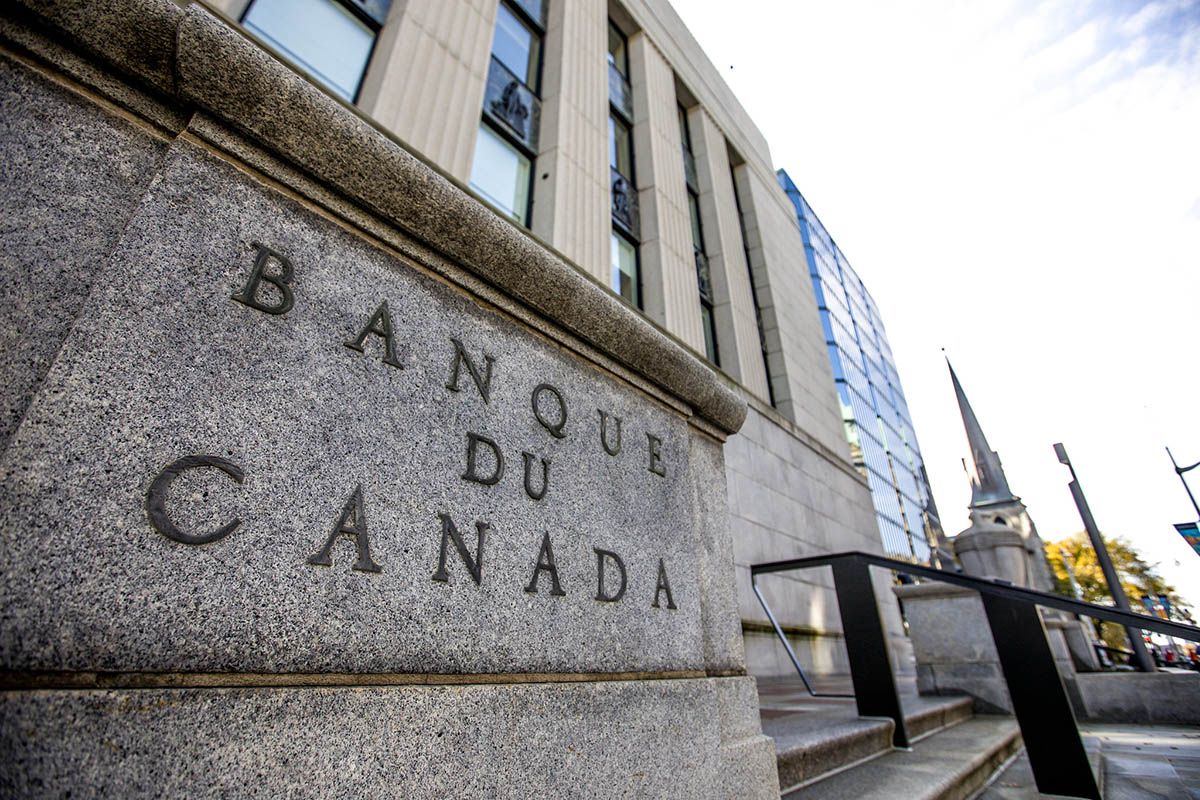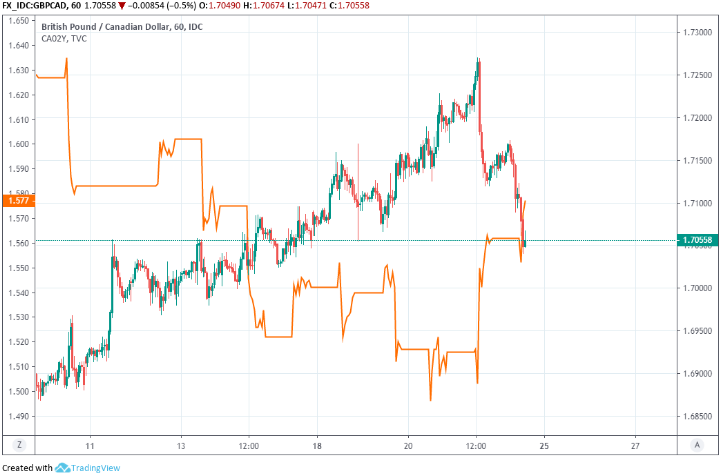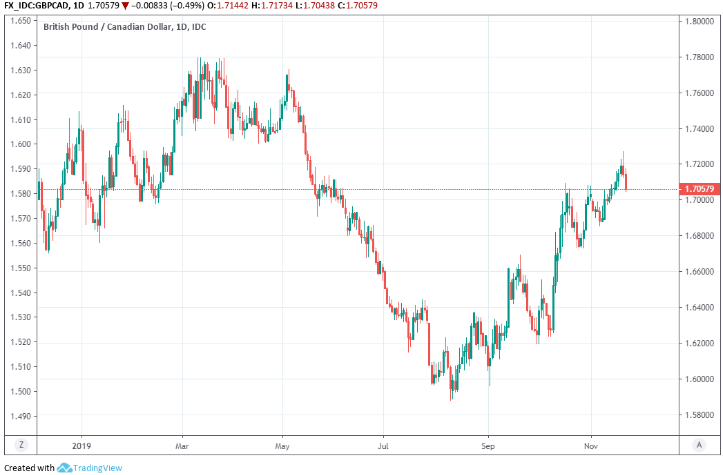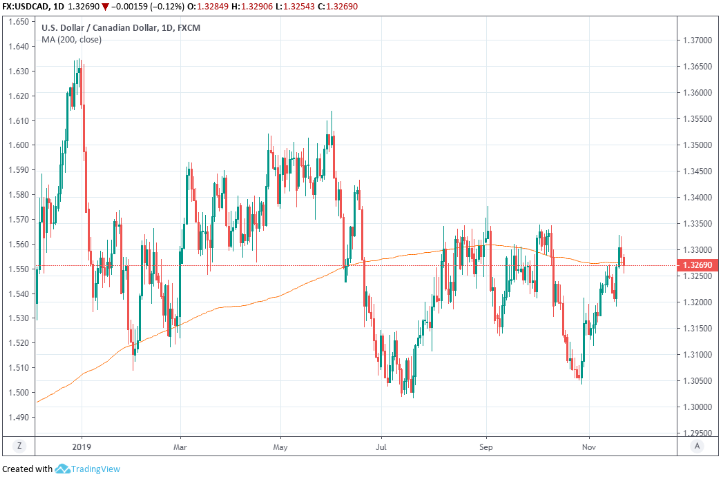Canadian Dollar Fights for Key Level as Retail Sales Keep Rate Cut Bets at Bay
- Written by: James Skinner

Image © Bank of Canada, Reproduced Under CC Licensing
- CAD builds gains over USD and GBP after retail sales beat.
- Sales growth softened in September but still beat consensus.
- Car and petrol sales weigh, other sectors see robust growth.
- Consumer sector key to BoC interest rate and CAD outlooks.
- CAD fights for USD/CAD close below 200-day moving-average.
- USD/CAD declines, broad GBP weakness aim GBP/CAD lower.
The Canadian Dollar built on earlier gains over its U.S. and British rivals Friday after September's retail sales data beat expectations and lifting government bond yields, taking the Loonie along for the ride, although whether the currency now overcomes a certain key level will dictate the outlook for the days ahead.
Canadian retail sales fell for the first time in three months in September, although not by as much as markets had anticipated. Sales were down 0.1% at the end of the last quarter, reversing a 0.1% gain from August but coming in ahead of a consensus that had looked for a 0.3% decline.
Core retail sales, which remove cars purchases from the data because of the distorting impact their large ticket prices can have on underlying trends, rose by 0.2% in September. That was ahead of the consensus for a 0.1% decline and more than reverses the 0.1% contraction seen in August.
"Canadians shopped with a bit more enthusiasm than expected in September, but this still wasn't a barnburner," says Avery Shenfeld, chief economist at CIBC Capital Markets. "In terms of the GDP contribution, note that in real terms, volumes were still -0.1% and and have been essentially flat since early 2018. Overall, better than expected, but not a good set of data in absolute terms."

Above: Pound-to-Canadian-Dollar rate shown at hourly intervals alongside 2-year CA Gov bond yield (orange line, left axis).
Friday's retail figures come less than a week away from the release of GDP data for the third-quarter, both of which are important for markets but expecially the retail figures because the Bank of Canada (BoC) is watching households closely. The BoC said last month it's looking for signs that an ongoing downturn in the manufacturing sector, and fall in business investment, is having an adverse impact on consumer spending and households.
Purportedly resilient households are the only thing standing between the Canadian cash rate of 1.75% and its next level down of 1.5%. BoC Governor Stephen Poloz reportedly told an audience at the Ontario Securities Commission Thursday that Canadian interest rates are "about right" for the current climate, barely a month after the bank omitted a similar and oft-repeated claim from the October policy statement.
"Despite a soft end to the quarter, retail sales volumes rose an annualized 1.9% in Q3, the best pace in a year. We expect overall consumer spending (part of next week's Q3 GDP report) rose at a similar pace. The BoC is keeping its eye on the household sector... It looks like both consumer spending and housing made solid contributions to growth last quarter," says Josh Nye, a senior economist at RBC Capital Markets.

Above: Pound-to-Canadian-Dollar rate shown at daily intervals.
Canada's Dollar shot higher following Poloz's remarks on Thursday after having been crushed earlier in the week when Deputy Governor Carolyn Wilkins appeared to suggest a so-far elusive rate cut could be around the corner.
She said "you want to put the winter tires on before the snow falls. It not only protects you, but also everyone else using the road," leading markets to believe she'd rather cut rates before the global slowdown arrives on Canadian shores, instead of waiting until after. She also floated "large-scale asset purchases," widely seen as a byword for a currency-crushing 'quantitative easing' program, as an option for fighting any downturn that materialises in the years ahead.
Poloz and the BoC have bucked the trend among peers this year, leaving rates unchanged at 1.75% even as the Federal Reserve and others cut in order to fend off a disinflationary global growth slowdown. Omitting the claim that rates are "appropriate" was seen as a hint that a cut could be on the horizon, but markets hadn't really taken the bank seriously until after Wilkins' speech.
"Yesterday should have been a better day for the CAD than it was; Governor Poloz’s comments reeled in near-term (at the very least) rate cut expectations back in to around a 10% chance of a cut in Dec and crude oil prices surged on hopes for OPEC production cuts. Although the CAD did nose a little higher, gains were perhaps less impressive than the backdrop would suggest," says Sean Osborne, chief FX strategist at Scotiabank.

Above: USD/CAD rate shown at daily intervals, with 200-day moving-average in orange.
Scotiabank says "intraday price signals" are bearish for the USD/CAD rate and that a move below 1.3270 could lead to a further 50 point decline. That's the level of the 200-day moving-average of prices marked on the chart above, which others have also tipped to give way this week. Whether or not the Loonie can force the U.S. Dollar to a daily close below that level could be key to how the Canadian currency trades in the early stages of the next week.
Currently the Loonie has the initiative over other currencies because of retreating expectations for a Bank of Canada rate cut either next month or at the January meeting. The USD/CAD rate is tipped by Scotiabank to go on declining and so too is Pound Sterling - relative to the U.S. Dollar - which could mean the Pound-to-Canadian-Dollar rate also remains in retreat over the coming days.
"The USD is on track for a positive week against the CAD but short term price action is suggesting that there may be a little more of a CAD bounce to come after Thursday’s drop back in the USD from the low 1.33 area," says Osborne's colleague Juan Manuel Herrera. "Sterling broke below the 1.289/90 neckline of a short-term double-top pattern this morning after peaking at 1.2971 intraday yesterday. Further weakness may take sterling to an area of support around 1.2840 where it traded through mid-week last week."
Time to move your money? Get 3-5% more currency than your bank would offer by using the services of a foreign exchange specialist. A specialist payments provider can deliver you an exchange rate closer to the real market rate than your bank would, thereby saving you substantial quantities of currency. Find out more here.
* Advertisement




